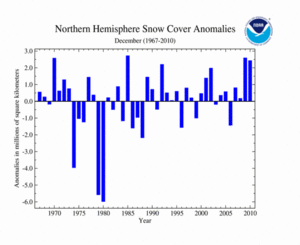NH Snow Cover Extent
Data were provided by the Global Snow Laboratory, Rutgers University. Period of record is 1967-2010 (44 years).
The Northern Hemisphere snow cover extent during December 2010 was much above-average, marking the fourth largest December snow cover extent on record — behind December 2009, 1985, and 1970. The December 2010 snow extent for the Northern Hemisphere was 2.4 million square km (0.9 million square miles) above the long-term average of 43.3 million square km (16.7 million square miles). Eurasia and North America both had above-average snow cover during the month. Numerous large winter storms occurred across the western and eastern United States and Western Europe. Please see the December 2010 Global Hazards report for additional information on these individual storms. According to a satellite analysis by the Rutgers Global Snow Lab, above-average snow cover was reported across eastern and western North America, most of Europe, and western Asia during December. Below average snow cover was reported for the central U.S. and across eastern and central Asia.
During December 2010, the North American snow cover extent was above average, ranking as the seventh largest on record. This marks the fourth consecutive December with above-average snow cover extent for the continent. The monthly average extent was 1.0 million square km (0.4 million square miles) above the long term average of 16.6 million square km (6.4 million square miles). According to data from the Rutgers Global Snow Lab, Canada, the contiguous U.S., and Alaska all had above-average snow coverage for the month. Cool conditions dominated the eastern U.S. and numerous storms affected the West coast contributing to the U.S. having much-above-average snow cover for the month. Several U.S. cities broke December monthly snowfall records — please see the December 2010 U.S. snow report for additional information.
Eurasian snow cover extent during December 2010 was also above average, ranking as the sixth largest on record. This is the second consecutive December with above-average snow cover extent for Eurasia, with snow and cold dominating the weather pattern across Western Europe during the month. The December 2010 Eurasian snow cover extent was 1.4 million square km (0.5 million square miles) above the long term average of 26.6 million square km (10.3 million square miles).
Sea Ice Extent
According to the National Snow and Ice Data Center (NSIDC), the Northern Hemisphere sea ice extent — which is measured from passive microwave instruments onboard NOAA satellites — averaged for December 2010, was 12.0 million square km (4.63 million square miles), 10.2 percent below the 1979-2000 average. This is the smallest December Arctic sea ice extent since records began in 1979. The December 2010 ice extent was 270,000 square km (104,000 square miles) smaller than the previous record low December extent in 2006. Arctic sea ice during December was below average on both the Atlantic and Pacific sides of the Arctic. Hudson Bay was particularly noteworthy because it was still not completely ice covered by the end of December, with the ice coverage roughly 50 percent of normal for the month. The bay is typically completely ice covered by the end of November. Northern Hemisphere ice extent for December has decreased at a rate of 3.4 percent per decade.
The below average Arctic sea ice was at least partially attributable to above-average air temperatures over Eastern Canada, Greenland, and eastern Siberia. Temperatures in these regions ranged from 6 to 10 degrees C (11 to 18 degrees F) above normal during December and sea ice coverage in these regions was below average. Meanwhile, temperatures were below-average for parts of Alaska and Scandinavia during December, and ice extent in these regions was near-to-above normal. These temperature patterns are associated with the strongly negative phase of the Arctic Oscillation, which dominated the weather pattern for the Northern Hemisphere high and middle latitudes during December. Abnormally high pressure was anchored over Eastern Canada and Greenland as well as the far northern Pacific Ocean. This pressure pattern contributed to the warmer-than-average temperatures across regions of the Arctic.
Conversely, during December 2010, the Southern Hemisphere sea ice extent was 8.87 percent above the 1979-2000 average. This was the sixth largest December Southern Hemisphere sea ice extent on record, and the fourth consecutive December with above-average ice extent. December Antarctic sea ice has increased at an average rate of 1.6 percent perdecade. Antarctic sea ice usually expands during the cold season to a September maximum, then contracts during the warm season to a March minimum.
For further information on the Northern and Southern Hemisphere snow and ice conditions, please visit the NSIDC News page, provided by NOAA's National Snow and Ice Data Center (NSIDC).
 NOAA's National Centers for Environmental Information
NOAA's National Centers for Environmental Information




